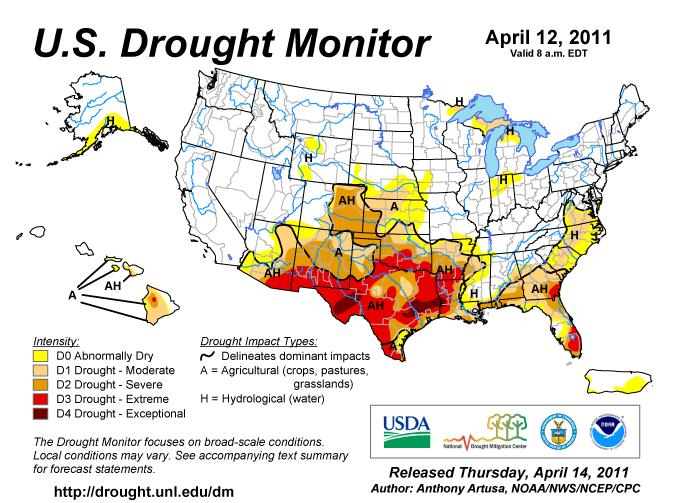Rains Make Little Dent to Drought in Southern Plains

According to this week's National Drought Monitor, moderate to locally heavy rains fell on northeast Oklahoma and southern Missouri, but appeared insufficient to substantially change drought conditions there.
"In the rest of the region, the theme of the last year was again played out: Little or no precipitation, and increasing moisture deficits except in small isolated areas. Several small adjustments were made in parts of the region, but of course the sprawling D4 area centered on Texas can’t be depicted any more seriously than it already was," states the monitor. "Some larger-scale changes included expansion of D4 with growing shorter-term deficits in southeast Oklahoma, a westward expansion of D0 to D3 conditions along the immediate southwestern Louisiana coast, and the extension of D1 conditions eastward to cover most of Arkansas. Several reports of dry pastures affecting livestock were noted, and despite recent near-normal precipitation, water supplies remain a concern in northwest Arkansas as well as throughout the large area of exceptional drought."
Meanwhile in the Midwest, several inches of rain eased dryness and drought in the upper Peninsula of Michigan, and more moderate rains kept drought depictions unchanged in the remainder of the Great Lakes region. "Farther west and south, in areas from central Kansas to northern Missouri and northward through the eastern Dakotas and Minnesota, short-term but intense dryness has led to the rapid development and expansion of dryness and drought. Many areas have received less than one-quarter of normal precipitation in the last 30 to 60 days, along with above normal temperatures," it states. " The rapid development of dryness quickly depleted topsoils, even leading to fires in some brush and even crop areas. Drought now covers areas from southeast Iowa to eastern South Dakota, with severe drought now observed in southern Minnesota."
But there is some hope for the Southern Plains, as the outlook calls for "a dramatic and long-overdue swath of moisture should push into the central and western Plains states, dropping over an inch of rain on a broad area from the northwestern half of Texas (except the Big Bend) northward through Nebraska and the adjacent Dakotas and Minnesota. Totals may reach 3.5 to 5.5 inches in central Nebraska and also southeastern parts of the Texas Panhandle."
Farther east, the outlook calls for a tropical system to spread heavy rains across Florida, southeastern Georgia and adjacent South Carolina. Over 1.5 inch is expected through this region, with as much as 8 inches possible along the southeast Florida coast. Elsewhere, anywhere from a few tenths of an inch to a couple of inches of precipitation should fall on parts of the Rockies, with light rain at best in other areas of dryness and drought.








